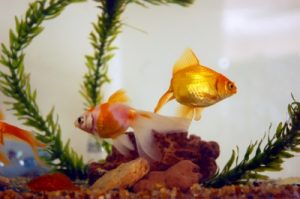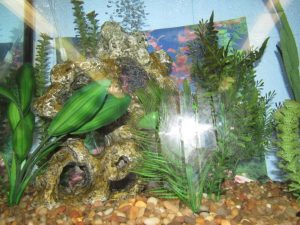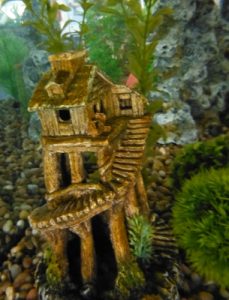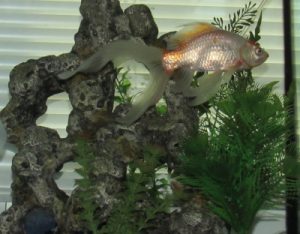In part one of this series, I spent a lot of time focusing on the size of tank that is considered appropriate for a goldfish home. Now we are going to get that new tank set up so that your fish can move in without too much stress. Getting things ready takes more time than you think, but isn’t necessarily a hassle. Most importantly, if you go through the process carefully, the transition from starter tank to permanent home should be smooth flowing for your finned friends.
One of the most important things about new tank setup from your goldfish’s perspective is the type of habitat you create for them. You are going to need gravel, plants, some kind of air supply, a net, at least one filter, tank cleaning tools, and some decorative objects that are more interactive, which I tend to refer to as “toys.” I could go on for days about brands and styles, but I’d rather let you do your own research on equipment and pick what is right for you. However, I will be giving some very necessary tips for decoration and installation that are important to the health and well-being of your fish.
Gravel
Let’s start with what most people choose to begin with: gravel. Whatever you put in the bottom of the new tank for your goldfish should be 1/8 of an inch or larger. Gravel size is important because your fish can swallow smaller stones or even get them stuck in their mouths. I use pebble sized rocks because Nix and Hydra are big enough now that anything else can easily be swallowed. If it ever looks like your fish could be swallowing gravel, change it out for something larger. Better yet, start with larger gravel and there will be no need to deal with the hassle later on.

This image shows an inappropriate setup for goldfish. The gravel is much too small and there is inadequate plant arrangement to provide them with proper shelter.
Plants
Fish owners usually go for the plants next. Goldfish need multiple plants to feel secure, not just one little thing that they can swim circles around. A variety of different sizes and shapes are necessary to give them proper hiding places and shelter. Goldfish don’t have eyelids, which means that when you suddenly flick a light on, it is startlingly bright and there is nothing they can do about it but dash around in the tank, unless they have plants to provide shadow and a place to hide that lessens the sudden light intensity. They also need to feel a sense of security and too little foliage leaves them feeling constantly vulnerable, which elevates their stress level, lowering their health drastically over time.
You can choose live or fake plants for your new tank, but keep in mind that plants are a part of the natural diet of goldfish, so live ones will most likely be replaced often. Live plants help with the biological balance of the tank, but you can meet these needs with pumps and filters, in which case plastic or silk plants will do just fine. If you decide on live plants, make sure to research which plants are the best match. Never use a plant that has opposite requirements to your fish. You need a live plant that has similar pH, temperature, and light requirements to your goldfish, otherwise you will find yourself unable to make both your fish and your plants happy at the same time. Plants that need artificial light should mostly be avoided because the artificial lights can heat the water, making it too warm and uncomfortable for goldfish. When purchasing fake plants, keep the “stocking test” in mind. If you run pantyhose over the plants and they snag, they are going to be too harsh on your fish when they swim around them.

The plastic plants included in this shot passed the pantyhose test, though they look as if they would not. Always watch your fish for signs of injury and replace plants if torn fins or missing scales are noticed.
Decoration!
The final item you are going to need for your new tank is some form of decorative object for landscaping. Sure, you can go without these, but who wants to see an unhappy fish that is losing color and sulking around their tank because they have nothing to explore? Adding some kind of interactive decoration provides the security and mental stimulation that your fish needs to be happy. The most important thing to remember about goldfish is to NEVER (let me say this again: NEVER!) use seashells in your goldfish aquarium! Seashells and pieces of coral are sharp and porous, meaning they could hurt your fish and will collect food and other debris, upsetting the cleanliness of your water. These items also break down naturally, making the water alkaline, which is not healthy for your fish.
It is always best to buy your decorations from a store that sells aquarium equipment, since they should only be selling items made of safe substances. If you chose to put something natural in your aquarium, look for rocks like slate, hard sandstone, and red shale, making certain they are smooth. When placing your landscaping rocks, be careful that you do not set larger stones in such a way that they could topple over and trap your fish or that the gaps could catch their delicate fins. You can also use petrified wood in your landscape design, but the same rules about sharp edges and toppling apply. Any decoration that has an entrance, such as a cave or building, should be chosen carefully. You need to be sure that your fish can not swim into the opening only to become trapped inside. After a while it is very hard to find objects large enough for growing goldfish to fit through, so don’t be afraid to arrange your tank so that they have a natural cave of sorts in a place between a decorative object and a plant. If they can’t have a real cave, that is the closest thing.

Nix and Hydra used to swim inside this house, now they are as big as it is. They became stressed when I removed this favorite object, so I use plants to create shelter around it. (Some were moved to better display the house for this image.)
Cleaning
Now before you put any of these items into your new tank, you need to clean everything, even if items claim they have already been cleaned. There is no way to know what these items have come in contact with between distribution and the time you picked them up in the store and you don’t want these things getting into the water of your newly created habitat. When it comes to gravel, the stones in those bags are always rubbing against each other, creating dust or breaking rocks, and as I have said before, any particles that are small or sharp could harm your fish.
The most important thing about cleaning items is that you NEVER use soaps and NEVER clean your tank or the items in it with hot water. Hot water will change the bacteria necessary in your tank and while there aren’t any on first set up, there will be some good, helpful bacteria in subsequent tank changes, which the hot water will kill. Soaps and other cleaners should be avoided for the same reasons and because of the chemicals they can introduce into your water. The same rule goes for items that you use to scrub or wipe with. If you decide to use a sponge to clean your tank, make certain you use one that is from the pet store. Any sponge or cleaning tool not made for fish could contain chemicals or glues that should never be placed in your fish tank.
If you want to sterilize something in your tank, use an aquarium salt solution of 6 tablespoons per gallon of water and soak your items in this solution for one hour, then rinse them all THOROUGHLY. Anything you want to dry should be dried with paper towels only, since fibers from cloth become trapped on items and are transferred into your tank. One of the most overlooked items that needs consistent cleaning is the fish net. Don’t forget to clean this EVERY time before you use it. You can also use the net to help you rinse out gravel. If you don’t want to use a net for gravel cleaning, a bucket will do. Just be sure to use a NEW bucket that has NEVER come into contact with soaps or cleaners of any kind, and designate that bucket as the only one to use for tank cleaning.
While all of these steps are extremely important, there is more to come! Keep an eye out for part three which will be out soon!
Mirrani Houpe, our Small Animal Editor, has had rats since she took home her first little boy once they both completed the second grade. Since that time she has owned, rescued and bred many kinds of rats, from many backgrounds. She may not be a vet, psychology major, or scientist, but her babies have her very well trained when it comes to how to care for them. She is constantly working with her family’s veterinarian to come up with new and innovative ways to love and care for the most often misunderstood rodent in the pet world. You can e-mail her at mirrani@yourpetspace.info



